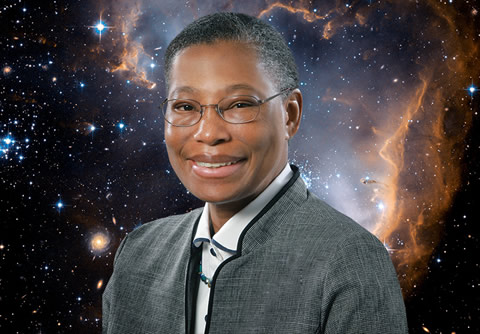As a child, Mercedes Richards (PhD 1986) used to marvel at the delicate beauty of stars in the night sky over her hometown of Kingston, Jamaica. As an astronomer, she’s now well acquainted with the deceptively violent character of nature’s most beautiful ornaments.
Currently a professor of astronomy and astrophysics at Pennsylvania State University, Richards specializes in the study of binary stars, stellar pairs that orbit around each other. One star in each close binary pair strips gas from its companion; the resultant pressure buildup can trigger an explosive outburst.
At U of T in the 1980s, Richards first investigated how such gas flow could be measured. Since then, she’s created a model for doing so using tomography (similar technology to that used in CT scans), and, more recently, “my collaborators and I have been able to create 3D images of these gas flows directly from observations,” she writes in an email. Many stars have twins, and Richards’ work enables scientists to understand more about their nature and ultimate fate.
In 2006, Richards took part in an explosive cosmic act herself: she was one of several hundred international astronomers who voted to redefine planets – resulting in a demotion for Pluto, now a dwarf planet. “The new definition,” she says, “states that a planet should be round in shape, it should travel along a direct path around the Sun, and its surroundings should not be cluttered with other objects.” Pluto sits within a region called the Kuiper Belt that contains thousands of objects – hence its diminished status.
This past summer was an exciting one for astronomers. First, the $100-million Breakthrough Listen search for extraterrestrial life was announced. Calling the initiative a “wonderful idea,” Richards goes on to say: “it would be naïve to think our civilization is the only one in the universe, especially since we have already confirmed the discovery of nearly 2,000 planets beyond our solar system.” Many of these, she says, orbit stars just like our sun.
Richards is also excited that – after nine and a half years – the New Horizons space probe finally got close enough to Pluto to photograph its craters, mountain ranges and moons. “New Horizons provides the same sense of adventure that the Voyager 1 and Voyager 2 missions realized about 30 years ago for my generation,” she says.
“An important aspect of my work is to convey a sense of excitement about the wonders of the universe,” Richards says. And it’s easier than ever before to get excited. Software such as Google Sky, Stellarium and Starry Night lets kids see stars online. You can even identify celestial objects just by pointing your smartphone skyward. “The youngest generation has very easy access to observation of the sky,” she says. “They never have to leave home to enjoy the heavens.”






